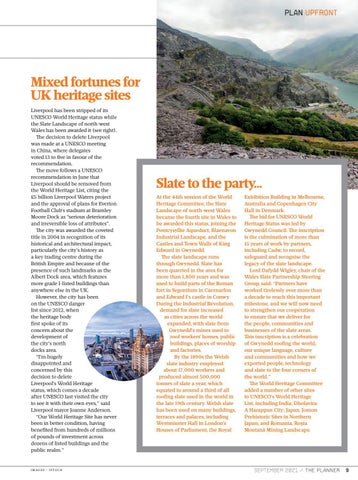PLAN UPFRONT
Mixed fortunes for UK heritage sites Liverpool has been stripped of its UNESCO World Heritage status while the Slate Landscape of north-west Wales has been awarded it (see right). The decision to delete Liverpool was made at a UNESCO meeting in China, where delegates voted 13 to five in favour of the recommendation. The move follows a UNESCO recommendation in June that Liverpool should be removed from the World Heritage List, citing the £5 billion Liverpool Waters project and the approval of plans for Everton Football Club’s stadium at Bramley Moore Dock as “serious deterioration and irreversible loss of attributes”. The city was awarded the coveted title in 2004 in recognition of its historical and architectural impact, particularly the city’s history as a key trading centre during the British Empire and because of the presence of such landmarks as the Albert Dock area, which features more grade I-listed buildings than anywhere else in the UK. However, the city has been on the UNESCO danger list since 2012, when the heritage body first spoke of its concern about the development of the city’s north docks area. “I’m hugely disappointed and concerned by this decision to delete Liverpool’s World Heritage status, which comes a decade after UNESCO last visited the city to see it with their own eyes,” said Liverpool mayor Joanne Anderson. “Our World Heritage Site has never been in better condition, having benefited from hundreds of millions of pounds of investment across dozens of listed buildings and the public realm.”
I M AG E S | I STO C K
8-9 News_September 2021_The Planner.indd 9
Slate to the party… At the 44th session of the World Heritage Committee, the Slate Landscape of north-west Wales became the fourth site in Wales to be awarded this status, joining the Pontcysyllte Aqueduct, Blaenavon Industrial Landscape, and the Castles and Town Walls of King Edward in Gwynedd. The slate landscape runs through Gwynedd. Slate has been quarried in the area for more than 1,800 years and was used to build parts of the Roman fort in Segontium in Caernarfon and Edward I’s castle in Conwy. During the Industrial Revolution, demand for slate increased as cities across the world expanded, with slate from Gwynedd’s mines used to roof workers' homes, public buildings, places of worship and factories. By the 1890s the Welsh slate industry employed about 17,000 workers and produced almost 500,000 tonnes of slate a year, which equated to around a third of all roofing slate used in the world in the late 19th century. Welsh slate has been used on many buildings, terraces and palaces, including Westminster Hall in London’s Houses of Parliament, the Royal
Exhibition Building in Melbourne, Australia and Copenhagen City Hall in Denmark. The bid for UNESCO World Heritage Status was led by Gwynedd Council. The inscription is the culmination of more than 15 years of work by partners, including Cadw, to record, safeguard and recognise the legacy of the slate landscape. Lord Dafydd Wigley, chair of the Wales Slate Partnership Steering Group, said: “Partners have worked tirelessly over more than a decade to reach this important milestone, and we will now need to strengthen our cooperation to ensure that we deliver for the people, communities and businesses of the slate areas. This inscription is a celebration of Gwynedd roofing the world, our unique language, culture and communities and how we exported people, technology and slate to the four corners of the world.” The World Heritage Committee added a number of other sites to UNESCO’s World Heritage List, including India, Dholavira: A Harappan City; Japan, Jomon Prehistoric Sites in Northern Japan; and Romania, Roșia Montană Mining Landscape.
S EPTE MB ER 2 021 / THE PLA NNER
9
11/08/2021 09:11




